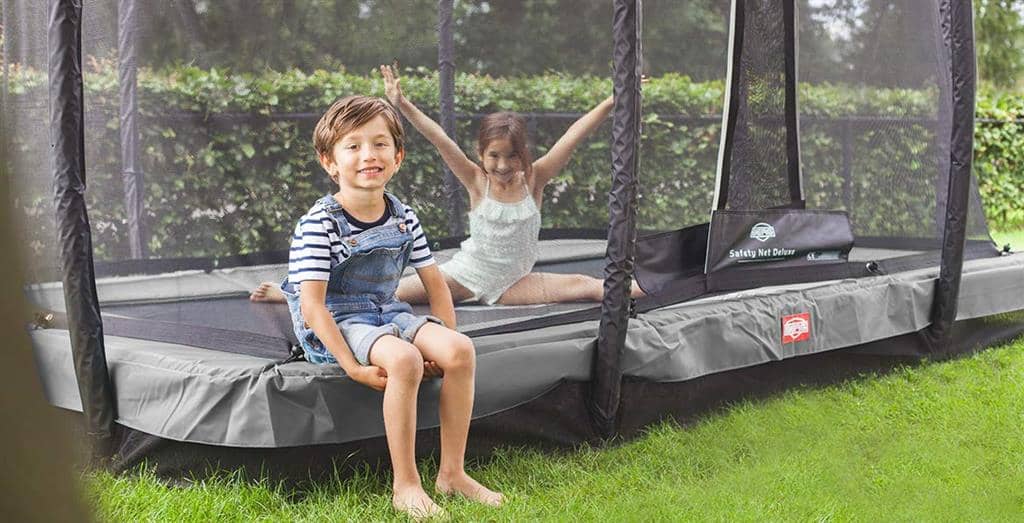Key Differences Between Inground Trampolines and Flatground Trampolines
Trampolines have long been a favourite addition to gardens, offering endless hours of fun, exercise, and entertainment. When considering a trampoline purchase, one of the key decisions is choosing between an inground trampoline and a flatground trampoline.
While both are installed at ground level, they have distinct features that impact performance, safety, aesthetics, and maintenance. This article explores the fundamental differences between inground and flatground trampolines to help you make an informed choice.
1. Installation Process
Inground Trampolines
- Inground trampolines are installed in a hole dug into the ground but sit slightly above the surface.
- The frame remains visible, typically raised a few inches to allow for better airflow.
- Airflow is an important consideration, so ventilation systems or gaps need to be incorporated to ensure bounce efficiency.
Flatground Trampolines
- Flatground trampolines are completely flush with the ground, creating a seamless integration into the landscape.
- Often includes an advanced airflow system to maintain bounce performance despite being fully embedded.
- The edge of the trampoline is often finished with special padding to blend with the surrounding area.
Key Difference: Flatground trampolines require more precise ground preparation and a stronger airflow system, whereas inground trampolines sit slightly above the ground with a more straightforward installation process.
2. Safety Considerations
Inground Trampolines
- The raised edge, although minimal, can still pose a slight tripping hazard.
- Safety enclosures are often recommended to prevent accidental falls off the edge.
- Easier access compared to above-ground trampolines, reducing the need for ladders.
Flatground Trampolines
- Because they are level with the ground, the risk of tripping is greatly minimized.
- Many flatground trampolines do not require safety nets, as users can easily step on and off without height concerns.
- Some models include extended safety padding around the perimeter for added protection.
Key Difference: Flatground trampolines have a lower fall risk due to their fully flush design, whereas inground trampolines may still benefit from a safety net to prevent falls from the slightly raised frame.
3. Aesthetic Appeal and Garden Integration
Inground Trampolines
- More visually discreet than above-ground models but still slightly raised above the lawn.
- Can blend well with the garden when placed in a designated play area.
Flatground Trampolines
- Offers a sleek, modern, and fully integrated look.
- Does not obstruct garden views and blends seamlessly with landscaping.
- Ideal for contemporary gardens and families prioritizing aesthetics.
Key Difference: Flatground trampolines offer a cleaner and more integrated appearance, while inground trampolines still have some frame visibility.
4. Bounce Performance and Airflow
Inground Trampolines
- Airflow is somewhat restricted due to the lower space beneath the mat.
- Requires a well-designed ventilation system, often using built-in vents or an open gap around the frame.
- Performance can be slightly reduced if airflow is not adequately managed.
Flatground Trampolines
- Features advanced airflow systems that allow better air movement beneath the jumping surface.
- Delivers a more consistent and powerful bounce compared to standard inground trampolines.
- Designed with airflow-enhancing materials to optimize jump efficiency.
Key Difference: Flatground trampolines generally offer superior bounce performance due to better airflow management, whereas inground trampolines require additional ventilation efforts.
5. Maintenance and Durability
Inground Trampolines
- Easier to maintain as they have slightly better drainage and fewer issues with dirt buildup.
- Still susceptible to leaves, debris, and water accumulation if not properly installed.
- Regular frame and mat checks are necessary to ensure longevity.
Flatground Trampolines
- Can collect more dirt, debris, and water as they sit completely level with the ground.
- Proper drainage is essential to prevent water pooling under the jumping mat.
- May require more frequent cleaning to maintain a smooth jumping surface.
Key Difference: Inground trampolines are slightly easier to maintain, while flatground trampolines need additional drainage considerations to prevent debris buildup.
6. Suitability for Different Users
Inground Trampolines
- Ideal for families with young children who need easier access.
- Great for casual jumpers and general backyard fun.
- Suitable for those who want a balance of aesthetics and performance.
Flatground Trampolines
- Preferred by experienced jumpers, gymnasts, and fitness enthusiasts who require optimal bounce.
- Excellent for households where multiple age groups use the trampoline.
- Provides a more professional feel, making it great for advanced jump techniques.
Key Difference: Flatground trampolines are better for serious jumpers and sports training, while inground trampolines are great for family-friendly play.
7. Cost Considerations
Inground Trampolines
- More affordable than flatground trampolines due to simpler installation.
- May require additional costs for retaining walls or ventilation solutions.
Flatground Trampolines
- Generally more expensive due to advanced airflow systems and precise ground installation.
- Higher initial investment but offers a premium experience.
Key Difference: Inground trampolines are more budget-friendly, while flatground trampolines require a higher investment for better bounce and aesthetics.
Conclusion: Which One Should You Choose?
Choose an Inground Trampoline if:
- You want an affordable ground-level trampoline.
- A slightly raised frame is not an issue.
- You are looking for a safe option for young children.
- Maintenance and easier installation are a priority.
Choose a Flatground Trampoline if:
- You prefer a sleek, seamless look in your garden.
- You need a trampoline with superior bounce performance.
- You want an option suited for sports and advanced jumping techniques.
- You’re willing to invest in a premium trampoline experience.
Ultimately, both inground and flatground trampolines offer fantastic outdoor fun, but understanding their differences can help you select the best option for your family’s needs. Whether prioritizing safety, aesthetics, performance, or budget, BERG and other leading trampoline brands offer excellent models in both categories to enhance your outdoor experience.
